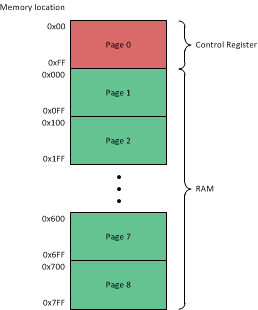JAJSGK4E March 2013 – January 2023 DRV2667
PRODUCTION DATA
- 1 特長
- 2 アプリケーション
- 3 概要
- 4 Revision History
- 5 Pin Configuration and Functions
- 6 Specifications
-
7 Detailed Description
- 7.1 Overview
- 7.2 Functional Block Diagram
- 7.3
Feature Description
- 7.3.1 Support for Haptic Piezo Actuators
- 7.3.2 Flexible Front End Interface
- 7.3.3 Ramp Down Behavior
- 7.3.4 Low Latency Startup
- 7.3.5 Low Power Standby Mode
- 7.3.6 Device Reset
- 7.3.7 Amplifier Gain
- 7.3.8 Adjustable Boost Voltage
- 7.3.9 Adjustable Current Limit
- 7.3.10 Internal Charge Pump
- 7.3.11 Device Protection
- 7.4 Device Functional Modes
- 7.5 Programming
- 7.6 Register Map
- 8 Application and Implementation
- 9 Power Supply Recommendations
- 10Layout
- 11Device and Documentation Support
- 12Mechanical, Packaging, and Orderable Information
パッケージ・オプション
メカニカル・データ(パッケージ|ピン)
- RGP|20
サーマルパッド・メカニカル・データ
- RGP|20
発注情報
7.5.3.1 Accessing the RAM
To maintain compatibility with the majority of standard I2C controllers, the DRV2667 device uses 8-bit addressing. To access 2 kB of RAM, a paging system is employed. The page register is located at address 0xFF. There are 8 memory pages that make up the 2048 bytes with 256 bytes on each page. Note that page 0 is reserved for register control space, as shown in #SLOS905DESC00N00.
 Figure 7-4 Page Structure
Figure 7-4 Page StructureBecause the device addresses are only 8-bits, a special exception exists to distinguish whether the user is trying to write the page register at address 0xFF or the memory location at 0xPFF, where P represents the page number. In order to access the page register, the programmer must use a Single-Byte I2C protocol to perform a single-byte write to memory location 0xFF (see GUID-463D7E45-0CA7-4BFB-B6EF-0131CC6CB773.html#GUID-463D7E45-0CA7-4BFB-B6EF-0131CC6CB773). To access the memory location in RAM at register 0xFF, the user must use the Incremental Multiple-Byte protocol (see GUID-AE9C22A1-C42B-4A18-B9FA-AA0B09D0E9C8.html#GUID-AE9C22A1-C42B-4A18-B9FA-AA0B09D0E9C8), and the beginning address must be less than 0xFF.
The page register automatically increments for multiple-byte writes that cross the page boundaries, as a convenience for filling memory across multiple pages. Multiple-byte reads across page boundaries are not supported. All memory is retained in the device until the device power is cycled.